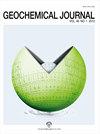单柱REE分离和放射成因<sup>143</sup>Nd/<sup>144</sup>Nd分析无Sm消去
IF 1.6
4区 地球科学
Q3 GEOCHEMISTRY & GEOPHYSICS
引用次数: 0
摘要
建立了一种测定自然地质样品放射性成因143Nd/144Nd比值的单柱分离方法。传统的放射性Nd同位素比值测量需要严格的柱化学,包括多个步骤来提取纯Nd分数。在分析过程中引起等压干扰的元素使用多柱分离方法去除,这通常是耗时和/或昂贵的。在这项工作中,我们使用单个阳离子交换柱提取Nd分数,并采用一种新的质量分馏校正方法来避免分析过程中Sm的等压效应。所开发的方法可以在不消除Sm的情况下精确测量143Nd/144Nd比率。145Nd/146Nd这两种没有天然等压线的非放射性Nd同位素之比用于校正143Nd/146Nd的仪器质量分馏。校正后的143Nd/146Nd比率可以使用常规使用的146Nd/144Nd常数比率0.721900转换为143Nd/144Nd形式,从而可以直接与已发表的文献和数据库进行比较。通过对玄武岩、花岗岩、沉积物和沉积岩等9种天然对照物质的样品制备,验证了该方法的适用性和鲁棒性,得到了精确的放射性143Nd/144Nd比值。本文章由计算机程序翻译,如有差异,请以英文原文为准。
Single Column REE Separation and Radiogenic <sup>143</sup>Nd/<sup>144</sup>Nd Analysis Without Sm Elimination
A single column separation method has been developed for the determination of radiogenic 143Nd/144Nd ratios for natural geological samples. Conventional radiogenic Nd isotope ratio measurements require rigorous column chemistry involving multiple steps to extract a pure Nd fraction. Elements that cause isobaric interference during analysis are removed using a multi-column separation method, which is often time consuming and/or expensive. In this work, we use a single cation exchange column to extract a Nd fraction, and a novel method of mass fractionation correction to circumvent the isobaric effect of Sm during analysis. The developed method allows accurate measurement of the 143Nd/144Nd ratio without the elimination of Sm. The ratio of two non-radiogenic Nd isotopes with no natural isobars, 145Nd/146Nd, is used to correct for instrumental mass fractionation on 143Nd/146Nd. The corrected 143Nd/146Nd ratios can be converted to the 143Nd/144Nd form using the conventionally used constant ratio of 146Nd/144Nd of 0.721900, allowing direct comparison with published literature and databases. We have implemented this sample preparation scheme to generate accurate and precise radiogenic 143Nd/144Nd ratios for nine natural reference materials including basalts, granites, sediments and sedimentary rocks, confirming the applicability and robustness of this technique.
求助全文
通过发布文献求助,成功后即可免费获取论文全文。
去求助
来源期刊

Geochemical Journal
地学-地球化学与地球物理
CiteScore
1.70
自引率
12.50%
发文量
11
审稿时长
6 months
期刊介绍:
Geochemical Journal is an international journal devoted to original research papers in geochemistry and cosmochemistry. It is the primary journal of the Geochemical Society of Japan. Areas of research are as follows:
Cosmochemistry; Mineral and Rock Chemistry; Volcanology and Hydrothermal Chemistry; Isotope Geochemistry and Geochronology; Atmospheric Chemistry; Hydro- and Marine Chemistry; Organic Geochemistry; Environmental Chemistry.
 求助内容:
求助内容: 应助结果提醒方式:
应助结果提醒方式:


